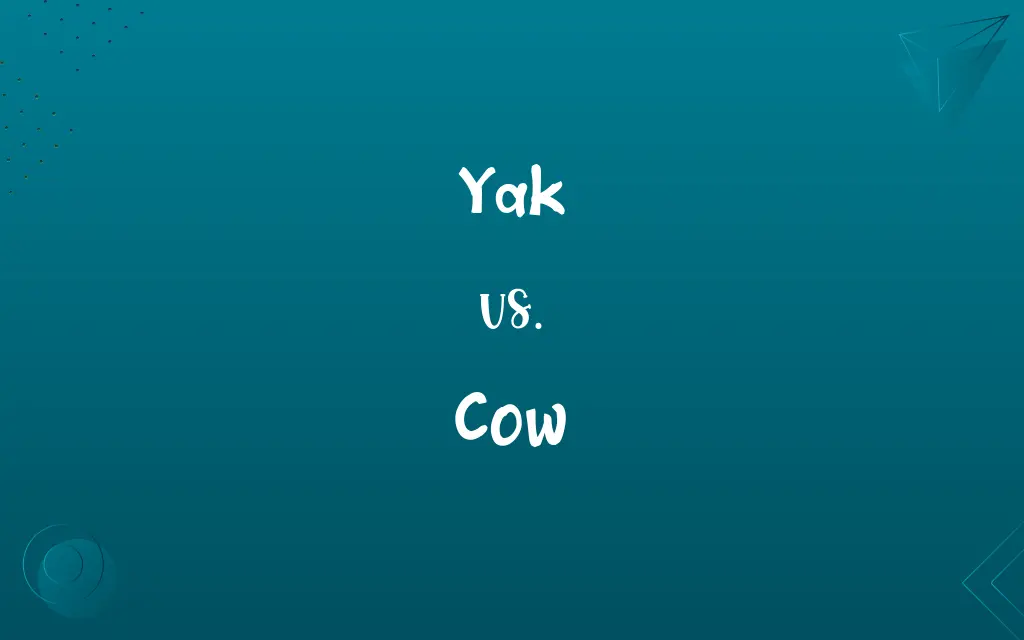Yak vs. Cow: Know the Difference

By Shumaila Saeed || Updated on December 25, 2023
Yaks are large, long-haired animals adapted to cold climates, primarily found in Central Asia, while cows are widespread domesticated animals used for dairy, meat, and labor.

Key Differences
Yaks are native to the Himalayan region of South Central Asia, Tibetan Plateau, and as far north as Mongolia and Russia. Cows, on the other hand, are domesticated globally with numerous breeds adapted to various environments. Yaks are distinguished by their long, dense fur suited for cold climates, whereas cows have shorter hair adapted to a wider range of climates.
Shumaila Saeed
Dec 06, 2023
Yaks are known for their ability to live at high altitudes, often over 15,000 feet, where they graze on sparse vegetation. Cows typically reside in lower altitudes and are a common sight in various landscapes from pastures to plains. The yak's physiological adaptations for high altitude living contrast with the cow's versatility in different environmental conditions.
Shumaila Saeed
Dec 06, 2023
Yaks are smaller than most cattle breeds, with sturdy frames and a more rugged appearance. Cows vary widely in size and build, depending on the breed, but generally, they are larger and less rugged than yaks. Yaks have a distinct appearance with their long hair and large horns, while cows have a more familiar and varied appearance based on breed.
Shumaila Saeed
Dec 06, 2023
In terms of utility, yaks are used primarily for their meat, milk, and wool, and as beasts of burden. Cows are primarily valued for their milk, meat, and leather, and in some cultures, as draft animals. While both are integral to agriculture and local economies, yaks are crucial for the livelihood of high-altitude communities, whereas cows have a more global economic significance.
Shumaila Saeed
Dec 06, 2023
Culturally, yaks hold significant value in Central Asian societies, often symbolizing strength and endurance. Cows, with their global presence, have varied cultural significances, revered in some cultures while primarily agricultural commodities in others. The cultural significance of yaks in Central Asian societies is distinct from the diverse roles cows play in different cultures worldwide.
Shumaila Saeed
Dec 06, 2023
ADVERTISEMENT
Comparison Chart
Native Habitat
Himalayan region, Central Asia.
Global, various environments.
Shumaila Saeed
Dec 06, 2023
Physical Adaptations
Long, dense fur for cold climates.
Shorter hair, adapted to diverse climates.
Shumaila Saeed
Dec 06, 2023
Altitude Adaptation
High altitude, over 15,000 feet.
Lower altitudes, various landscapes.
Shumaila Saeed
Dec 06, 2023
Size and Build
Smaller, sturdy, rugged appearance.
Larger, varying sizes and builds.
Shumaila Saeed
Dec 06, 2023
ADVERTISEMENT
Cultural Significance
Significant in Central Asian societies.
Varied, ranging from reverence to commodity.
Shumaila Saeed
Dec 06, 2023
Yak and Cow Definitions
Yak
A large domesticated wild ox with shaggy hair, humped shoulders, and large horns.
The yak grazed peacefully on the Himalayan mountainside.
Shumaila Saeed
Dec 06, 2023
Cow
A fully grown female animal of a domesticated breed of ox, used as a source of milk or beef.
The farmer milked the cow at dawn.
Shumaila Saeed
Dec 06, 2023
Yak
An animal well-adapted to high altitudes and cold climates.
The yak's thick coat protects it from the harsh winter.
Shumaila Saeed
Dec 06, 2023
Cow
An animal often used in agricultural settings for plowing and other tasks.
The farmer used the cow for plowing the small field.
Shumaila Saeed
Dec 06, 2023
ADVERTISEMENT
Yak
A source of milk, meat, and wool, and a beast of burden in Central Asia.
The villagers relied on the yak for transportation of goods.
Shumaila Saeed
Dec 06, 2023
Cow
A symbol of wealth and fertility in various cultures.
In some cultures, owning cows is a sign of prosperity.
Shumaila Saeed
Dec 06, 2023
Yak
An important animal in Tibetan culture and economy.
Yaks are central to the nomadic lifestyle of many Tibetans.
Shumaila Saeed
Dec 06, 2023
Cow
An animal with diverse breeds adapted to different environments.
The Holstein cow is known for its high milk production.
Shumaila Saeed
Dec 06, 2023
Yak
A symbol of endurance and strength in high-altitude regions.
The yak embodies the resilience needed to survive in the mountains.
Shumaila Saeed
Dec 06, 2023
Yak
A wild, shaggy-haired ox (Bos grunniens) of the mountains of central Asia.
Shumaila Saeed
Oct 19, 2023
Cow
The mature female of certain other large animals, such as elephants, moose, or whales.
Shumaila Saeed
Oct 19, 2023
Cow
An adult female of the species Bos taurus, especially one that has calved.
Cow milk is the most common form of milk in Europe.
Shumaila Saeed
Oct 19, 2023
Yak
An ox-like mammal native to the Himalayas, Mongolia, Burma, and Tibet with dark, long, and silky hair, a horse-like tail, and a full, bushy mane.
Shumaila Saeed
Oct 19, 2023
Cow
(formerly inexact but now common) Any member of the species Bos taurus regardless of sex or age, including bulls and calves.
Shumaila Saeed
Oct 19, 2023
Cow
(uncommon) Beef: the meat of cattle as food.
The only meat I eat is cow.
Shumaila Saeed
Oct 19, 2023
Cow
(uncommon) Any bovines or bovids generally, including yaks, buffalo, etc.
Shumaila Saeed
Oct 19, 2023
Cow
(biology) A female member of other large species of mammal, including the bovines, moose, whales, seals, hippos, rhinos, manatees, and elephants.
Shumaila Saeed
Oct 19, 2023
Cow
A woman considered unpleasant in some way, particularly one considered nasty, stupid, fat, lazy, or difficult.
Shumaila Saeed
Oct 19, 2023
Yak
To talk, particularly informally but persistently; to chatter or prattle.
Shumaila Saeed
Oct 19, 2023
Cow
To intimidate; to daunt the spirits or courage of.
Con artists are not cowed by the law.
Shumaila Saeed
Oct 19, 2023
Yak
A bovine mammal (Poëphagus grunnies) native of the high plains of Central Asia. Its neck, the outer side of its legs, and its flanks, are covered with long, flowing, fine hair. Its tail is long and bushy, often white, and is valued as an ornament and for other purposes in India and China. There are several domesticated varieties, some of which lack the mane and the long hair on the flanks. Called also chauri gua, grunting cow, grunting ox, sarlac, sarlik, and sarluc.
Shumaila Saeed
Oct 19, 2023
Cow
To depress with fear; to daunt the spirits or courage of; to overawe.
To vanquish a people already cowed.
THe French king was cowed.
Shumaila Saeed
Oct 19, 2023
Cow
Subdue, restrain, or overcome by affecting with a feeling of awe; frighten (as with threats)
Shumaila Saeed
Oct 19, 2023
Cow
A common livestock animal farmed for its dairy products, meat, and hide.
The cows in the field grazed calmly throughout the day.
Shumaila Saeed
Dec 06, 2023
Repeatedly Asked Queries
Can yaks survive in low altitude areas?
Yaks are best adapted to high altitudes but can survive in lower altitudes under proper care.
Shumaila Saeed
Dec 06, 2023
Do yaks produce milk?
Yes, yaks produce milk which is a staple in the diet of people in some Central Asian cultures.
Shumaila Saeed
Dec 06, 2023
What are cows primarily used for?
Cows are primarily used for dairy products, meat, and leather, and sometimes as draft animals.
Shumaila Saeed
Dec 06, 2023
Are cows found worldwide?
Yes, cows are domesticated and found in a variety of environments globally.
Shumaila Saeed
Dec 06, 2023
What is the main habitat of yaks?
Yaks primarily inhabit high-altitude regions in Central Asia.
Shumaila Saeed
Dec 06, 2023
How do cows adapt to different environments?
Through selective breeding, cows have been adapted to a range of environments.
Shumaila Saeed
Dec 06, 2023
Are all cows used for dairy production?
Not all; some breeds are specifically raised for beef or work.
Shumaila Saeed
Dec 06, 2023
Is yak wool used commercially?
Yes, yak wool is valued for its warmth and is used in various textiles.
Shumaila Saeed
Dec 06, 2023
How long do cows usually live?
Domestic cows typically live for 15 to 20 years.
Shumaila Saeed
Dec 06, 2023
Do cows have cultural significance?
Yes, cows are revered in some cultures and hold various symbolic meanings.
Shumaila Saeed
Dec 06, 2023
Are yaks social animals?
Yaks are generally social and can be found in herds.
Shumaila Saeed
Dec 06, 2023
Are yaks considered sacred in any culture?
While not typically considered sacred, yaks hold significant cultural value in Central Asian societies.
Shumaila Saeed
Dec 06, 2023
Do cows form herds?
Yes, cows are also social animals and naturally form herds.
Shumaila Saeed
Dec 06, 2023
Are cows intelligent animals?
Cows are known to have a certain level of intelligence and social complexity.
Shumaila Saeed
Dec 06, 2023
What is the diet of a cow?
Cows are primarily herbivores, feeding on grass, hay, and sometimes grain.
Shumaila Saeed
Dec 06, 2023
Are yaks endangered?
Some species of wild yaks are considered vulnerable, but domestic yaks are not endangered.
Shumaila Saeed
Dec 06, 2023
Can cows live in cold climates?
Certain breeds of cows can adapt to colder climates, but generally not as extreme as yaks.
Shumaila Saeed
Dec 06, 2023
Do yaks require special care?
Yaks are hardy animals but require care suited to their high-altitude environment.
Shumaila Saeed
Dec 06, 2023
Can yaks be used for plowing or farming?
Yaks are primarily used for carrying loads rather than plowing.
Shumaila Saeed
Dec 06, 2023
Share this page
Link for your blog / website
HTML
Link to share via messenger
About Author
Written by
Shumaila SaeedShumaila Saeed, an expert content creator with 6 years of experience, specializes in distilling complex topics into easily digestible comparisons, shining a light on the nuances that both inform and educate readers with clarity and accuracy.







































































